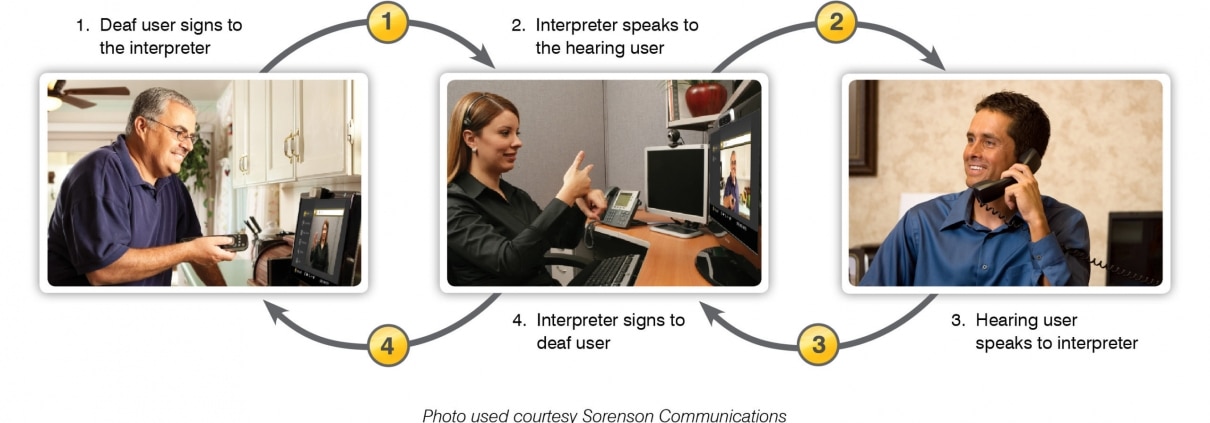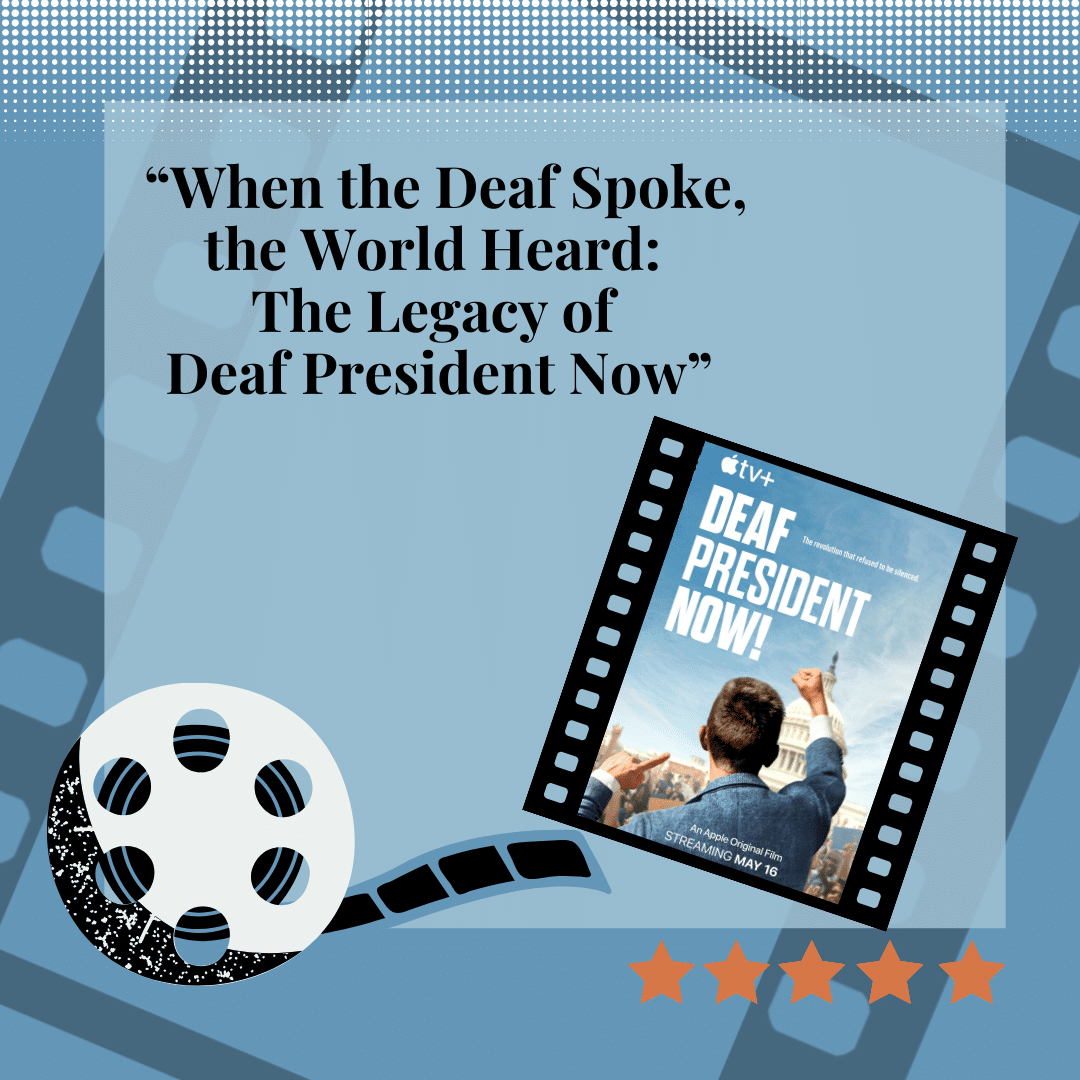
Video Relay Services for the Deaf and Hard of Hearing
- by Jessica M.


Video Relay Services (VRS) are a type of video relay services that many Deaf, hard of hearing, Deafblind people and people with speech disabilities use to communicate to hearing callers with the help of an American Sign Language (ASL) interpreter (Wikipedia: VRS, 2021). In a VRS call, Deaf/hard of hearing callers can see the sign language interpreter on their computers, mobile phones, or iPADs, and the interpreter would dial the number that the callers want to reach. The sign language interpreter translates what the hearing person says over the phone into sign language for the Deaf/hard of hearing caller to understand. Then the Deaf/hard of hearing caller signs back as the sign language interpreter voices so that the hearing person can understand what is being said.
VRS became widely available in the U.S. in 2003 when Sorenson Media Inc. came up with a video software that made video calls possible (Sorenson, 2021). All calls are free since they are made through the internet. The U.S. Federal Communications Commission (FCC) authorized VRS to be used widely in 2002.
In fact, VRS calls are much quicker compared to using TTYs. When VRS didn’t exist, the Deaf community communicated with each other and with hearing people through TTYs, which stands for text telephone. In this type of call, TTY users had to type each word to communicate with each other instead of listening to one another. Also, when TTYs were around, Deaf people had to call hearing people by using a different type of relay service that had hearing operators relaying calls between them and hearing people. A Deaf person would call a specific relay number via TTY where a hearing operator would dial the number that the Deaf person wants to reach to speak with a hearing caller. The operator listens to what the hearing person says, then types word for word for the Deaf person to read on his/her TTY. The process is very time consuming. Uneducated hearing callers often think relay calls as scams or collect calls, so the Deaf caller often needs to call that person repeatedly explaining that it was a relay call, not a collect or telemarketing call.
Additionally, before TTYs were around in the 1960’s, Deaf people had to make appointments, etc. in person or by writing letters since they were unable to use the phone like hearing people. Hearing family members often made phone calls for the Deaf person as well (Gallaudet, 2021).
However, with today’s technology with computers, mobile phones, and various other devices, VRS has made communication between Deaf people and hearing people much easier and faster. In the U.S., there are several companies run by Deaf people that offer VRS such as Sorenson Communications LLC, Convo Communications LLC, ASL Services Holdings LLC (branded as GlobalVRS), and ZP Better Together LLC (this company merged ZVRS and Purple together) (Federal Communications Commission: TRS-General, 2021). All of those VRS companies offer devices to Deaf and hard of hearing users for free of charge, and certified to offer VRS services to clients via the Internet.
The video relay services provided by all the VRS companies are funded by the U.S. government’s Telecommunications Relay Service (TRS) fund, in compliance to the Americans with Disabilities Act under Title IV amended by the FCC. VRS is available in all 50 states, Washington D.C., Puerto Rico, and in all other U.S. territories (Federal Communications Commission: TRS, 2021). VRS users can call locally, long distance, and internationally for free of charge.
Each VRS company is based in different cities throughout the U.S. For example, Sorenson Communications, LLC is the oldest VRS company in the U.S. and is based in Salt Lake City, and this company offers more than 100 ASL interpreting centers throughout the U.S. (Sorenson: About, 2021). Convo Communications, LLC is one of the largest Deaf-owned companies in the U.S., and is based in Pleasanton, CA (Convo, 2021 and FCC: TRS-General, 2021). Additionally, GlobalVRS (owned by ASL Services Holdings LLC) is based in Florida and this company offers video relay services for both English and Spanish speakers (GlobalVRS, 2021). Finally, ZP Better Together merged Purple and ZVRS under one company, and is based in Austin, TX. However, this company still maintains Purple and ZVRS as two separate brands and their merged website is zvrs.com (ZVRS, 2021).
Each VRS company mentioned above offers its own app that Deaf callers can use to download on their devices such as on their iPhones, iPADs, laptops, and androids. However, each company also has its own products such as desktop computers or laptops that Deaf callers can receive for free of charge to make calls. All of the VRS companies also offer Spanish-speaking sign language interpreters who are trilingual. In fact other VRS companies exist in countries such as in Europe, Asia, and Australia to name a few.
The population who uses VRS have different needs. For example, a Deaf sighted person can use VRS to call a hearing person via a sign language interpreter that they can see on screen. Additionally, a Deaf person can call another Deaf person by using a videophone where they can see each other on screen and communicate in sign language.
However, a hearing person who has a speech disability also can use VRS but use a different type of middle person which is known as speech-to-speech relay service (Federal Communications Commission, STS, 2021). The operator who listens to the person with the speech disability is trained to understand different levels of speech clarity. That operator then would verbally repeat what the caller is saying so the listener can clearly understand what the caller is saying. People with speech disabilities can have conditions such as cerebral palsy, multiple sclerosis, stroke, stutter, etc.
Speaking of a DeafBlind person making VRS calls to a hearing person, a DeafBlind person can use this special software called myMMX which comes with choices of how to communicate (Access256 Productions, LLC, 2021). For example, a DeafBlind person can choose to speak or type during the call and the software would adapt to that person’s needs to talk to a hearing person, another DeafBlind person, or a Deaf person. In this case, if the DeafBlind person cannot see the sign language interpreter via VRS while calling either a hearing or Deaf person, the caller can understand what the sign language interpreter says via braille display made possible by the myMMX software (Access256 Productions, LLC, 2021). On the other hand, if the DeafBlind person has some residual vision, he/she can read what the sign language interpreter is saying through an enhanced text on screen. Furthermore, a DeafBlind person can call another DeafBlind person using myMMX where they both can communicate with one another via braille or enhanced text. Finally, if a DeafBlind person does not know braille or cannot read text, he or she can also listen to what the person is saying by audition if that person is hard of hearing. The audio can be customized in specific ways to get rid of accents or incomprehensible pitch. Captioned Telephone services are also available through this type of software to give the DeafBlind person options of how to communicate via VRS.
References:
Access256 Productions, LLC, 2021. https://deafblindvp.me
Convo, 2021. https://www.convorelay.com/about-us
Federal Communications Commission, TRS, 2021 https://www.fcc.gov/trs
Federal Communications Commission: TRS-General, 2021 https://www.fcc.gov/general/internet-based-trs-providers
Federal Communications Commission: STS, 2021. https://www.fcc.gov/consumers/guides/speech-speech-relay-service
Gallaudet University, 2021. https://www.gallaudet.edu/history-through-deaf-eyes/online-exhibition/awareness-access-and-change/telephones-and-ttys/
GlobalVRS, 2021. https://globalvrs.com/about-global-vrs-providers/
Sorenson: About, 2021. https://www.sorenson.com/about/
Wikipedia: VRS, 2021. https://en.m.wikipedia.org/wiki/Video_relay_service#Telecommunications-facilitated_signing
ZVRS, 2021. https://www.zvrs.com/acquisition/info-for-purple-customers/
Start Learning ASL Today!
 Ready to start learning real American Sign Language and not just basic signs? Do you want to be a part of the vibrant Deaf community? Check out our Free ASL 1 Course or our Complete 4-Level ASL Course options and start learning ASL today!
Ready to start learning real American Sign Language and not just basic signs? Do you want to be a part of the vibrant Deaf community? Check out our Free ASL 1 Course or our Complete 4-Level ASL Course options and start learning ASL today!








